Scottish Health Survey - topic report: mental health and wellbeing
The Scottish Health Survey (SHeS) provides information on the health and factors relating to the health of people living in Scotland that cannot be obtained from other sources. This topic report is secondary analysis of the 2012 and 2013 surveys, exploring factors associated with the mental health and wellbeing of adults aged 16 years and older.
This document is part of a collection
5. Behaviours and Health conditions
5.1 Factors associated with low mental wellbeing
This section includes analysis of WEMWBS and GHQ12 scores for factors relating to health behaviours and conditions. Factors which are associated with below average WEMWBS scores or GHQ12 scores of four or greater are shown in Table 5A. These factors were selected for inclusion in the regression analyses presented in this chapter.
Health-related factors, 2012/2013
| WEMWBS | GHQ12 | |
|---|---|---|
| Physical activity | Y | Y |
| Alcohol use | Y | Y |
| Smoking | Y | Y |
| Fruit and vegetable consumption | Y | |
| COPD (doctor-diagnosed) | Y |
5.1.1 Physical activity
Background
Physical activity has many well documented health benefits, including associations with improved mental wellbeing as explored in the literature review. Amongst other Scottish Government policy initiatives, the National Performance Framework (NPF) includes a national indicator to increase activity levels among adults[c], monitored using SHeS data. Physical activity guidelines[d] state that adults should engage in at least 150 minutes of moderate activity a week (alternatively, 75 minutes of vigorous activity spread across the week also meets the recommendations)[e].
The Scottish Health Survey asks about four main types of physical activity: home-based activities, walking, sport and exercise and activity at work, covering (for each) information on the time spent being physically active, intensity and the frequency with which the activity was undertaken. For information on how this is translated into a measure of whether or not the physical activity guideline was met, see the 2013 main report[f]. Table 5B shows how activity levels have been categorised for this analysis.
Table 5B
Physical activity guidelines: description of categories
| Physical activity category | Physical activity per week: description |
|---|---|
| Meets guideline | 150 minutes per week of moderate activity, 75 minutes of vigorous activity, or an equivalent combination of moderate and vigorous activity |
| Some activity | 60-149 minutes of moderate activity, 30-74 minutes of vigorous activity, or an equivalent combination of moderate and vigorous activity |
| Low activity | 30-59 minutes of moderate activity, 15-29 minutes of vigorous activity, or an equivalent combination of moderate and vigorous activity |
| Very low activity | Less than 30 minutes of moderate activity, less than 15 minutes of vigorous activity, or less than an equivalent combination of these |
In 2012/2013, 63% of adults (62% in 2012, 64% in 2013) were physically active at the recommended level. The proportion of men meeting the guideline (69%) was significantly greater than the proportion among women (58%). Activity levels are generally higher among the younger age groups, with 77% of those aged 16-24 active at the recommended level, declining steadily to 69% between ages 45 and 54, before tailing off more sharply to just over half (52%) of adults aged 65-74 and a quarter (26%) aged 75+ meeting recommendations.
Results
Higher WEMWBS scores were associated with those adults who met the recommended physical activity guideline. Age-standardised scores in this group (mean score 51.4) were significantly higher than in all others, while scores in the 'very low activity' category (46.0) were significantly lower than in others (48.5 and 49.6 for those in the 'low' and 'some' activity groups).
Figure 5A
Figure 5A
WEMWBS mean scores, by physical activity level, 2012/2013
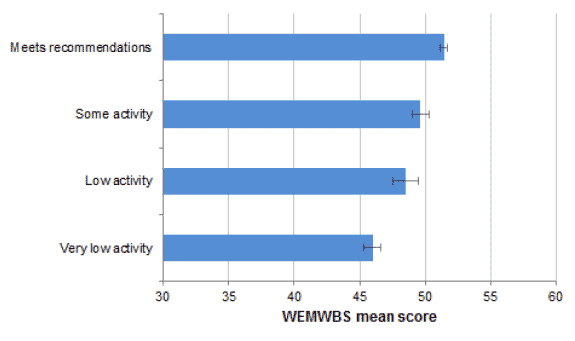
Of adults who attain very low levels of physical activity, three in ten (30%) exhibited signs of a possible psychiatric disorder. This figure was significantly greater than the proportion among those who attained higher activity levels, in particular those who met physical activity recommendations, of whom 11% exhibited signs of a possible psychiatric disorder.
Figure 5B
Figure 5B
Proportion of adults with GHQ12 scores of four or higher, by physical activity level, 2012/2013
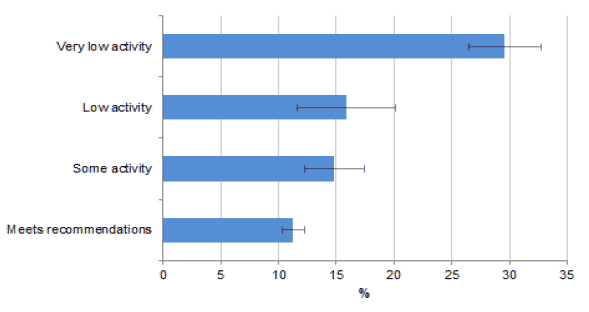
Physical activity levels are also significantly associated with mental wellbeing measures in the logistic regression analyses, indicating that it is a significant predictor of mental wellbeing after controlling for the other independent factors described in these results. In WEMWBS, men (OR 2.20; CL 1.59, 3.04) and women (OR 2.47; CL 1.97, 3.11) attaining very low activity levels are significantly more likely to have a low score compared to those meeting recommended levels. Similarly, in the model for GHQ12 scores of greater than four, men (OR 2.00; CL 1.43, 2.78) and women (OR 1.86; CL 1.50, 2.31) with very low activity levels are more likely to exhibit signs of a possible psychiatric disorder than those meeting recommended levels. While these results support the hypothesis that a lack of physical exercise is associated with poor mental health, as noted in the literature review the effect may be bi-directional.
Tables 6A and 6B
Comparison of the mean scores for each of the components that make up the overall WEMWBS score shows significant differences extend across all fourteen components. Those who meet the recommendations consistently score higher than those who do not, with the difference most noticeable in the component question on 'energy levels' (i.e. those meeting the recommendations typically have more 'energy to spare'). Men and women who meet the guideline are significantly less likely to score negatively for this component compared to those in any of the other activity categories.
Table 5C
Table 5C
WEMWBS statement 'I've had energy to spare': results of logistic regression analysis indicating a low score, by physical activity level and sex, 2012/2013
| Physical activity level | Odds ratio |
95% confidence limits |
||
|---|---|---|---|---|
| Men | Some activity vs Meets recommendations |
1.42 | 1.11 | 1.83 |
| Low activity vs Meets recommendations |
2.08 | 1.44 | 3.01 | |
| Very low activity vs Meets recommendations |
2.88 | 2.33 | 3.55 | |
| Physical activity level | Odds ratio |
95% confidence limits |
||
|---|---|---|---|---|
| Women | Some activity vs Meets recommendations |
1.51 | 1.28 | 1.80 |
| Low activity vs Meets recommendations |
1.74 | 1.35 | 2.23 | |
| Very low activity vs Meets recommendations |
2.81 | 2.37 | 3.35 | |
5.1.2 Alcohol consumption
Background
Sensible drinking guidelines in the UK recommend that women should not regularly drink more than 2-3 units of alcohol, and men should not regularly drink more than 3-4 units, per day. The Scottish Government recommends that everyone should aim to have at least two alcohol free days per week. It is also recommended that, over the course of a week, women and men should not consume more than 14 and 21 units respectively.
Three aspects of alcohol consumption are covered by the Scottish Health
Survey: weekly consumption, consumption on the heaviest drinking day in the last week, and alcohol use disorder identification, including signs of alcohol dependence. This report focuses on two measures of alcohol consumption: (i) weekly consumption, and (ii) the Alcohol Use Disorders Identification Test (AUDIT)[g].
For drinking levels derived from unit consumption, respondents have been classified into 'non-drinkers', 'moderate' and 'hazardous/harmful' drinkers, based on self-reported consumption. Full details on the methods used to derive weekly units from the SHeS questionnaire are described in the 2013 report.
The term 'harmful drinking' is used to describe those who are drinking at a level which is already causing physical, social or psychological harm. People whose drinking is not currently causing clear evidence of harm, but which may cause harm in the future, are described as 'hazardous' drinkers. In terms of units[h], men who consume over 21 and up to 50 units per week and women who consume over 14 and up to 35 units are described as 'hazardous' drinkers. Those who consume above 50 units (for men) or 35 units (for women) per week are described as drinking at 'harmful' levels.
In 2012/2013, 16% of adults (12% of men and 19% of women) were non-drinkers, 64% (64% of men, 65% of women) were moderate drinkers, while the remaining 20% (23% of men, 17% of women) drank at hazardous or harmful levels. Around one in five adults aged 16-74 are hazardous/harmful drinkers. Prevalence is highest in the 55-64 (23%) and 45-54 (22%) age groups. Only 8% of adults aged 75+ are hazardous or harmful drinkers.
AUDIT was mainly designed to identify high-risk alcohol behaviour, or alcohol dependency, but can also be used to categorise low or medium risk groups. Results here focus on two categories - 'no dependency on alcohol' (AUDIT scores 0-19) and 'possible alcohol dependence' (AUDIT scores of 20 or higher).
Results
WEMWBS scores among non-drinkers (47.6) were significantly lower than among drinkers. However, there was no significant difference in WEMWBS scores between moderate (50.3) and hazardous/harmful drinkers (50.6).
Figure 5C
Figure 5C
WEMWBS mean scores, by drinking classification and sex, 2012/2013
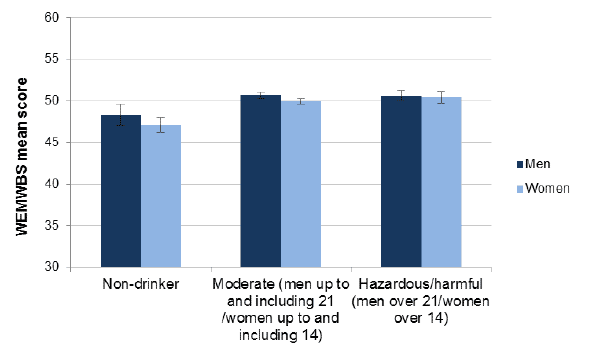
A significantly higher proportion of non-drinkers (27%) exhibited signs of a possible psychiatric disorder compared to moderate (13%) or hazardous/harmful (13%) drinkers
Figure 5D
Figure 5D
Proportion of adults with GHQ12 scores of four or higher, by drinking classification and sex, 2012/2013
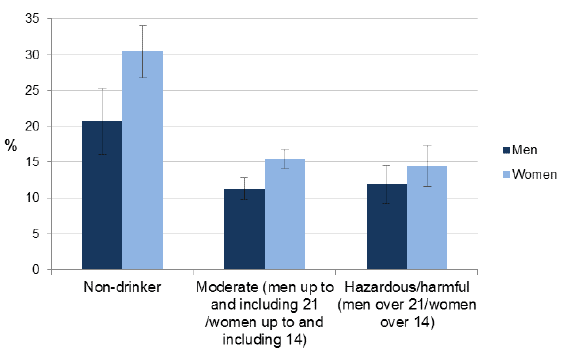
It should be noted that the non-drinker group may contain a number of former drinkers, including those abstaining due to past alcohol misuse, or those who cannot drink due to a health (including mental health) concern. Additionally, the hazardous and harmful groups are likely to contain respondents who just exceed the guideline but do not show signs of alcohol dependence or some other high risk behaviours. Finally, these results do not cover 'binge' drinking (or daily recommended limits).
AUDIT results show that those with possible alcohol dependence had significantly poorer mental wellbeing than those without (WEMWBS age-standardised scores of 41.0 and 50.0 respectively). Although the sample size of adults with an AUDIT score of 20 or greater was very small in 2012/2013 (less than 100), a statistically significant difference between these groups was observed in each of the fourteen component questions that make up the overall WEMWBS score.
Around half (51%) of adults who were identified as possibly alcohol dependent in 2012/2013 also exhibit signs of a possible psychiatric disorder. In spite of large confidence intervals, due to the relatively small number of respondents who are alcohol dependent, this result was significantly higher than the equivalent proportion among adults who had 'no [alcohol] dependency', of whom 15% exhibited signs of a possible psychiatric disorder.
Possible alcohol dependence was significantly associated with WEMWBS and GHQ12 measures of mental health after controlling for the other demographic, health behaviour and conditions described in this report. Men (OR 3.45; CL 1.58, 7.53) and women (OR 4.66; CL 1.77, 12.22) who score more than 20 on AUDIT (i.e. who are possibly alcohol dependent) are more likely to have a low mental wellbeing score. Results are also significant for men (OR 5.24; CL 2.44, 11.25) and women (OR 3.29; CL 1.33, 8.14) with a possible dependence on alcohol in regard to showing signs of a possible psychiatric disorder, supporting the literature review findings on mental health and alcohol use disorders.
Tables 6A and 6B
Men and women with possible alcohol dependence are both particularly likely to respond negatively to the statements, 'been thinking clearly' (odds ratios 4.49 and 5.37 respectively), 'been feeling unhappy and depressed' (odds ratios 5.71, 3.78), and 'been thinking of self as worthless' (odds ratios 7.26, 4.21).
5.1.3 Smoking
Background
The Scottish Health Survey covers various aspect of smoking behaviour, from current smoking status, past smoking behaviour, frequency of smoking, exposure to second hand smoke and attempts (and desire) to give up smoking. This section presents results by current smoking status, with results shown separately for current smokers, ex-smokers and those who have never smoked.
Information about cigarette smoking was collected from adults aged 16 and 17 in a self-completion questionnaire, which offers privacy to answer without disclosing their smoking behaviour in front of other household members who may be present during the interview. Respondents aged 18 and 19 answered the questions either in the main interview or in the self-completion booklet, at the interviewer's discretion, and adults aged 20 and over were all asked these questions as part of the main interview.
In 2012/2013, 23% of adults reported that they currently smoked cigarettes (25% in 2012; 21% in 2013) while 28% were ex-smokers and the remaining 49% said they had never been a smoker.
Results
Current smokers have significantly lower WEMWBS scores than both ex-smokers and those who have never smoked (means of 47.5, 50.1 and 51.0 respectively). Although results were similar for ex-smokers and those who have never smoked, this difference was also statistically significant.
Figure 5E
Figure 5E
WEMWBS mean scores, by smoking status and sex, 2012/2013
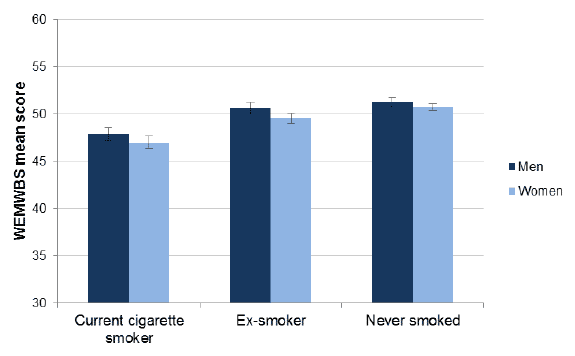
Among current smokers, the proportion exhibiting signs of a possible psychiatric disorder (23%) is significantly higher than the equivalent proportions amongst those who are ex-smokers (16%) or have never smoked (12%). The difference between the latter groups is also statistically significant.
Figure 5F
As these results are age-standardised, this is not simply a reflection of the different age profile of smokers, ex-smokers and non-smokers. Indeed, smoking is a significant predictor for low mental wellbeing and signs of a psychiatric disorder after controlling for each of the other factors described in this section. Female non-smokers have significantly lower odds (OR 0.72; CL 0.56, 0.92) of a low WEMWBS score, while non-smokers in both sexes are less likely to exhibit signs of a possible psychiatric disorder compared to smokers (men: OR 0.68; CL 0.49, 0.94; women: OR 0.78, CL 0.62, 0.97).
Tables 6A and 6B
Figure 5F
Proportion of adults with GHQ12 scores of four or higher, by smoking status and sex, 2012/2013
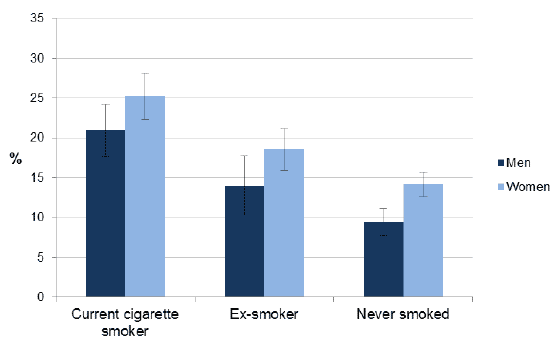
5.1.4 Fruit and Vegetable Consumption
Background
The most widely recognised diet guidance is the World Health Organisation (WHO) 'five a day' advice for adults to consume at least five varied portions of fruit and vegetables per day.
To determine the total number of portions consumed in the 24 hours preceding the interview, the survey includes questions about consumption of: fresh, frozen or canned vegetables; salads; pulses; vegetables in composites; fresh, frozen or canned fruit; dried fruit; and fruit in composites. For details on how the survey uses this to provide information against the five-a-day guideline, including visual aids to assist with interpretation of portion sizes, see the 2013 main report[i].
In 2012/2013, one in five (21%) adults met the five-a-day guideline, including 21% of men and 22% of women, while 11% of men and 8% of women reported eating no fruit or vegetables at all the day prior to their Scottish Health Survey interview.
Results
Respondents who meet this recommendation exhibit considerably higher WEMWBS scores (51.6; 51.8 for men and 51.3 for women) than those who eat less than the recommended number of portions (49.9; 50.4 and 49.5 respectively) or none at all (46.3; 47.2 and 45.1 respectively). The difference in WEMWBS scores between men and women is widest amongst those who eat no fruit or vegetables, and appears to reduce as the number of portions consumed increases.
Adults who ate no fruit or vegetables in the day prior to interview were more likely to exhibit signs of the presence of a possible psychiatric disorder (21%), compared to those who eat some (15%) or those who met the recommended daily intake (14%). One in four (26%) women who ate no fruit or vegetables have a GHQ12 score of four or higher, considerably higher than the proportion among men (16%).
Fruit and vegetable consumption is a significant predictor of mental health and wellbeing after controlling for other factors. Women who eat some fruit and vegetables are significantly less likely (OR 1.85; CL 1.36, 2.50) to have a below average WEMWBS score than those who do not eat any fruit or vegetables. The gap between those who eat some and those who meet the guideline is not statistically significant; nor are the results for men.
Table 6A
5.1.5 Obesity
Background
Scottish Health Survey participants' height and weight measurements are taken during their interview. Details of the protocols used for collecting height and weight are included in the Scottish Health Survey 2013 report.
Body Mass Index (BMI), defined as weight (kg)/height (m2), is a widely accepted measure that allows for differences in weight due to height, and is the main obesity measure in survey. It should be noted that BMI has some limitations (WHO, 2000). For example, it makes no distinction between body fat and muscular mass. Nor does it take account of the distribution of fat throughout the body (i.e. body shape, or waist circumference). Although waist circumference data is also collected in the survey, for the purposes of this report mental wellbeing has only been examined together with weight classifications based on BMI. The weight groups used in this report are presented in Table 5D.
Table 5D
BMI categories and definitions
| BMI | Definition |
|---|---|
| Less than 18.5 | Underweight |
| 18.5 to less than 25 | Healthy weight |
| 25 to less than 30 | Overweight |
| 30 to less than 40 | Obese |
| 40+ | Morbidly obese |
In 2012/2013, a third of adults (34%) were in the healthy weight range. Around two thirds (64%) of adults were overweight, including 25% who were obese and 2% who were morbidly obese. More men (68%) than women (61%) are overweight including obese categories. However, more women than men are obese (or morbidly obese) - 28% overall compared to 26%.
Results
Among men, WEMWBS scores fluctuate as BMI increases, between 47.5 (underweight) and 50.7 (overweight). The mean score for those in the healthy weight range is 50.4.
For women, the highest WEMWBS score is observed in the healthy weight group (50.3), although this is not significantly higher than the mean in the overweight group (50.0). There is then a reduction as BMI (by grouping) increases, to 48.5 in the obese and 48.0 in the morbidly obese groups. As with men, the lowest WEMWBS mean score is among women with an underweight BMI (46.2) - significantly lower than for all other BMI groups despite a low sample size.
Figure 5G
Figure 5G
WEMWBS mean scores, by BMI classification and sex, 2012/2013
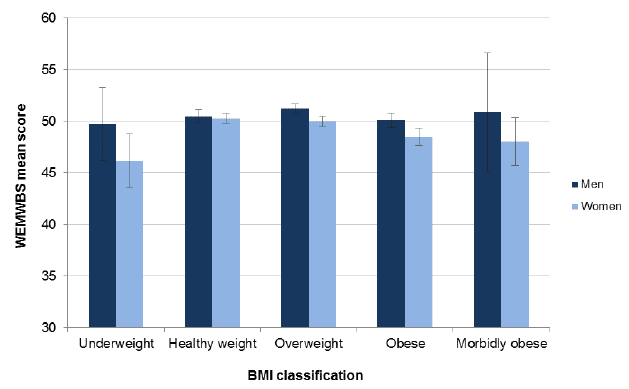
Among women, from the healthy weight range and upwards, the proportion who exhibit signs of a possible psychiatric disorder increases with increasing BMI (by grouping) - with 16% of those in the healthy and overweight ranges, 20% of those who are obese and 22% of those who are morbidly obese scoring four or higher on the GHQ12 scale. Among the underweight group, 30% of women score four or higher on GHQ12, but this is not a statistically significant increase on the other BMI groups due to the relatively small sample size in this range.
For men, the pattern is less clear, with a similarly high (27%) but statistically insignificant proportion in the underweight group exhibiting signs of a possible psychiatric disorder. Men who are overweight are least likely to have a GHQ12 score of four or higher (10%) but the proportion does not vary significantly among any of the BMI groups.
It is worth noting that obesity was not identified as a significant factor in multivariate analyses - for WEMWBS or GHQ12 - after controlling for other socio-economic and health-related factors.
5.1.6 Eating together
Scottish Health Survey participants, except those who live in one-person households, are asked how many times household members in the last week ate a main meal together, excluding breakfast[j].
In 2012/2013, four in ten (39%) reported eating together seven times per week, with a further 26% eating together more frequently still. Around one in eight either ate together one or two times per week (12%), three or four times (12%), or five or six times (13%) per week, while 8% reported never eating meals together.
The mean score on the WEMWBS scale among adults who never eat meals together (48.0) is considerably lower than among those who eat together three or more times in a week. There is a gradual reduction in the mean score as the number of weekly meals increases to above three or four (51.9). Those eating together five or six times have a mean score of 51.1, dropping to 50.8 and 50.2 among those who eat together seven times per week, or more frequently, respectively.
One quarter (26%) of adults who never eat together display signs of the presence of a possible psychiatric disorder, considerably higher than the proportion among those who eat together three or four times per week (9%). As the number of meals taken together increases above three or four, this proportion steadily increases to 14% among those who eat together more than seven times per week, which remains lower than among those who never eat together (26%).
Although eating together in the household is strongly correlated with positive scores in WEMWBS and GHQ12, this was not included in final multivariate logistic regression models after testing for collinearity with other variables. Eating together was shown to be highly associated with marital status, which was included.
However, the positive impact on mental wellbeing, particularly among children and adolescents, of regularly eating meals together as a family, has been highlighted in the literature review in this report. These results provide some evidence that eating meals together may be a significant factor in mental wellbeing among adults.
5.1.7 Doctor-diagnosed health conditions
Survey participants were asked whether they had suffered from any of the following CVD and respiratory-related conditions: angina, heart attack, stroke, heart murmur, irregular heart rhythm, 'other heart trouble', diabetes, asthma and COPD, including whether any of these conditions were ever diagnosed by a doctor. Such doctor-diagnoses have been used in this report to identify adults who have specific conditions. Type 1 and type 2 diabetes are not separately identified.
Doctor-diagnosed conditions are categorised and analysed in the following groups in this report:
- High blood pressure
- Diabetes
- Angina, heart attack or stroke
- Asthma
- COPD
In 2012/2013, 23% of adults had high blood pressure, 6% had diabetes and 8% had angina, a heart attack or stroke diagnosed by a doctor. Prevalence of each of these conditions increased with age.
Prevalence of high blood pressure ranged from 2% of adults aged 16-24, increasing steadily to 21% of adults aged 45-54 and then increasing more sharply to half (48%) aged 65-74 and 57% among those aged 75+.
Diabetes prevalence steadily increases from 1% of those in the youngest adult age groups (16-24, 25-34) to 7% of those aged 55-64 before rising to 13% of those aged 65-74 and 15 of those aged 75+.
The number of survey participants aged 16-34 who had doctor-diagnosed angina, a heart attack or stroke was close to zero. Prevalence then increased to 2% of those aged 35-44 and 4% of those aged 45-64 before rising more sharply in the 55-64 (12%), 65-74 (20%) and 75+ (34%) age groups.
Around 16% of adults reported having asthma diagnosed, with prevalence highest in the 16-24 age group (24%) and decreasing steadily as age increases (to a low of 10% in the 75+ group).
Doctor-diagnosed COPD prevalence in 2012/2013 was 4%. Less than 1% of 16-34 year olds reported this condition, rising to 2% and 3% in 35-44 and 45-54 age groups respectively. Prevalence then increases again to 7% in the 55-64 age group, 8% in the 65-74 group and 10% in the 75+ group.
Results
Mean WEMWBS scores vary considerably between adults with and without the doctor-diagnosed conditions outlined above. In each case, the mean score was significantly lower among those who had been diagnosed with one (or more) of these conditions compared to those who had not.
Among adults who had been diagnosed with high blood pressure, the mean WEMWBS score in 2012/2013 was 48.8, significantly lower than the mean (50.3) for those who did not report this diagnosis. For diabetes, the equivalent figures were 47.6 and 50.1; and for angina, heart attack or stroke they were 47.1 and 50.2. Those reporting an asthma diagnosis scored 48.9, compared to 50.2 for those who did not, while equivalent figures for those with a COPD diagnosis were 45.3 and 50.1 respectively.
Figure 5H
Figure 5H
WEMWBS mean scores, by doctor-diagnosed condition (not age-standardised), 2012/2013

The proportion of adults exhibiting signs of the presence of a possible psychiatric disorder, based on GHQ responses, also varies considerably between those with and without these conditions.
Around one in five (19%) adults with high blood pressure had a GHQ12 score of four or higher, similar to the proportion among those with diabetes (18%). For high blood pressure, this was significantly higher than the proportion among those who do not have the condition (14%). For diabetes, the difference compared to the group without the condition (15% of whom had a GHQ12 score of four or higher) was not statistically significant.
One in four (25%) adults with doctor-diagnosed angina, heart attack or stroke showed signs of the presence of a possible psychiatric disorder, significantly higher than the proportion among those without any of these diagnoses (15%).
One in five (20%) adults with doctor-diagnosed asthma, and more than one third (35%) of those with COPD diagnosed, exhibited signs of the presence of a possible psychiatric disorder. Again these figures were significantly higher than for those who did not report such diagnoses (14% and 15% respectively).
COPD is also significant predictor of low mental health and wellbeing after controlling for other factors. Men and women who do not have COPD are significantly less likely to exhibit signs of the presence of a possible psychiatric disorder (men - OR 0.35, CL 0.22, 0.58; women - OR 0.49, CL 0.33, 0.74). Also, men without COPD are less likely to have a below average WEMWBS score (OR 0.57; CL 0.35, 0.93).
Tables 6A and 6B
CVD conditions (grouped together) and doctor diagnosed asthma were both shown to be correlated with low mental health and wellbeing (for WEMWBS and GHQ12) but were not included in final regression models due to their strong relationship with other included predictors. This includes a strong association between CVD prevalence and age, and asthma with COPD and physical activity.
Contact
Email: Craig Kellock
There is a problem
Thanks for your feedback